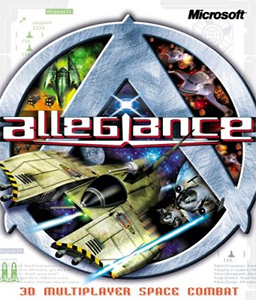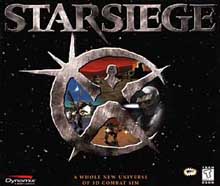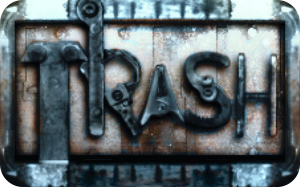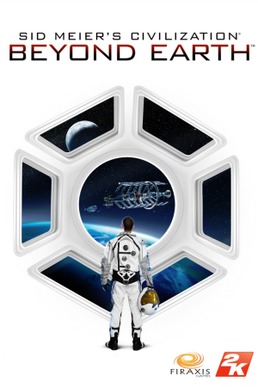
Sid Meier's Alpha Centauri is a 4X video game, considered a spiritual sequel to the Civilization series. Set in a science fiction depiction of the 22nd century, the game begins as seven competing ideological factions land on the planet Chiron ("Planet") in the Alpha Centauri star system. As the game progresses, Planet's growing sentience becomes a formidable obstacle to the human colonists.

Allegiance is a multiplayer online game initially developed by Microsoft Research. It is notable for providing a mix of real-time strategy and player piloted space combat gameplay.

Earth 2150, also known as Earth 2150: Escape from the Blue Planet, is a real-time strategy game, originally published in 2000 by SSI and Polish developer Reality Pump and a sequel to Earth 2140. 2150 was one of the first commercial full-3D games of its kind. A sequel to Earth 2150, Earth 2160, was published in August 2005. The game also has two stand-alone expansion packs: Earth 2150: The Moon Project, and Earth 2150: Lost Souls.

Starsiege is a mecha-style vehicle simulation game developed by Dynamix and released in 1999. Starsiege is set in the Metaltech/Earthsiege universe, which contains its predecessors Earthsiege (1994), Battledrome (1994), and Earthsiege 2 (1996). This universe also includes action game Hunter Hunted (1996), strategy games Mission Force: Cyberstorm (1996) and Cyberstorm 2: Corporate Wars (1998). It also includes the sequelsStarsiege: Tribes and all subsequent Tribes titles. In 2015, this game and the rest of the Metaltech/Tribes series were released as freeware by Hi-Rez Studios, but Battledrome and the Cyberstorm series were not.

Battlezone is a first-person shooter real-time strategy video game, developed and published by Activision. It was released for Microsoft Windows in 1998. Aside from the name and presence of tanks, this game bears little resemblance to the original arcade game of the same name. Activision remade it into a hybrid of a tank simulation game, a first-person shooter and a real-time strategy game. In Battlezone the player is controlling everything on the battlefield from the first person view.

Earth 2150: The Moon Project is a sequel to the real time strategy game Earth 2150. While the game is in fact a stand-alone game, many consider it an expansion pack because it does little more than provide new missions, and weapons. The story takes place alongside the original game's story. The Moon Project was released in 2000 by Strategic Simulations, Inc.

Earth 2140 is a 2D real-time strategy computer game created in 1997 by Polish-based Reality Pump Studios and published by TopWare Interactive. It has two sequels, Earth 2150 and Earth 2160.

Command & Conquer: Tiberian Sun is a 1999 real-time strategy video game developed by Westwood Studios, published by Electronic Arts, and released exclusively for Microsoft Windows in August 1999. The game is the sequel to the 1995 game Command & Conquer. It featured new semi-3D graphics, a more futuristic sci-fi setting, and new gameplay features such as vehicles capable of hovering or burrowing. The main story of the game focuses on a second war between the UN-backed Global Defense Initiative (GDI) and the cult-like Brotherhood of Nod, both seeking to rule over an Earth which is undergoing rapid ecological collapse.

Trash is a real-time strategy computer game developed by Inhuman Games for the Microsoft Windows operating systems. It was released on September 20, 2005.

Outpost 2: Divided Destiny is a real-time strategy computer game developed by Dynamix, released in 1997 by Sierra Entertainment. It reuses and refines some of the concepts from the original Outpost, but there is no direct continuity between the storylines or the gameplay.

Urban Assault is a 3D combined first-person shooter and real-time strategy computer game developed by the German company TerraTools and published by Microsoft in the year 1998.

The Spring Engine is a game engine for real-time strategy (RTS) video games. The game engine is free and open-source software, subject to the terms of the GNU General Public License v2.0 or later.

Sins of a Solar Empire is a 2008 science fiction real-time strategy video game developed by Ironclad Games and published by Stardock Entertainment for Microsoft Windows operating systems. It is a real-time strategy (RTS) game that incorporates some elements from 4X games; its makers describe it as "RT4X". Players are given control of a spacefaring empire in the distant future, and are tasked with conquering star systems using military, economic and diplomatic means.

Warhammer 40,000: Dawn of War – Dark Crusade is the second expansion to the real-time strategy video game Warhammer 40,000: Dawn of War developed by Relic Entertainment and published by THQ. Based on Games Workshop's tabletop wargame, Warhammer 40,000, Dark Crusade was released on October 9, 2006. The expansion features two new races, the Tau Empire and the Necrons. Including the Imperial Guard from Dawn of War's first expansion pack Winter Assault, a total of seven playable races in this expansion.

Earth 2150: Lost Souls is the second sequel to the real time strategy game Earth 2150. While it is a stand-alone game, many consider it the second expansion pack because it does little more than provide new missions, and weapons. The story takes place alongside the original game's story. Lost Souls was released in 2002.
Red Faction is a series of shooter video games developed by Volition and owned by Plaion. Originating in 2001, the Red Faction games have spanned Microsoft Windows, macOS and consoles, including the PlayStation 2, GameCube, Xbox, PlayStation 3 and Xbox 360. Original developers Volition have retained the rights to the series since 2020, with no updates provided on whether a future fifth game is in the works or may be so in the future.

Far Gate is a video game released for Microsoft Windows. It was developed by Super X Studios and published by Microïds. The gameplay consists of 3D space-based real-time strategy, and allows players to play as any of three distinct factions employing different units and structures. It was one of the first video games to offer fully 3D space-based real time strategy.

Supreme Commander is a 2007 real-time strategy video game designed by Chris Taylor and developed by his company, Gas Powered Games. The game is considered to be a spiritual successor, not a direct sequel, to Taylor's 1997 game Total Annihilation, and also the Spring remake. First announced in the August 2005 edition of PC Gamer magazine, the game was released in Europe on February 16, 2007, and in North America on February 20.

Sid Meier's Civilization: Beyond Earth is a turn-based strategy, 4X video game in the Civilization series developed by Firaxis Games, published by 2K Games and released for Microsoft Windows on October 24, 2014, the Mac App Store on November 27, 2014 and for Linux on December 18, 2014. The game's premise is that Earth became uninhabitable due to an undescribed disaster known as "the Great Mistake", forcing humanity to colonize space. As a spiritual successor to the 1999 game Alpha Centauri, Beyond Earth shares much of its development team and some concepts, most notably its setting on an exoplanet in the future.

Sid Meier's Civilization: Beyond Earth – Rising Tide, is an official expansion pack for the turn-based strategy video game Civilization: Beyond Earth. It was released on October 9, 2015.

















